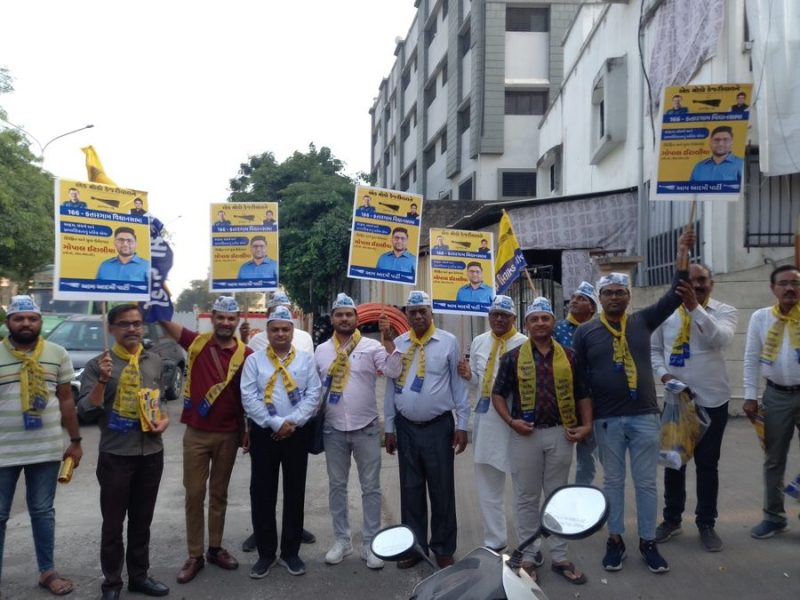
AAP now a national party despite poor show in Gujarat, HP; what this means

The Aam Aadmi Party (AAP) scored a naught in Himachal Pradesh and a dismal five seats in Gujarat. But AAP chief Arvind Kejriwal was a happy man on Thursday. He thanked the people of Gujarat and his party workers for helping turn AAP into a national party — only in 10 years.
राष्ट्रीय पार्टी बनने पर आम आदमी पार्टी के सभी कार्यकर्ताओं और सभी देशवासियों को बधाई। pic.twitter.com/sba9Q1sz1f
— Arvind Kejriwal (@ArvindKejriwal) December 8, 2022
So, what makes a national party and how did AAP achieve this feat? Read on to know more.
What is a national party?
To put it very simply, a national party has national presence, as opposed to a state party that is restricted to a state or region. Incidentally, once a party gains national status, it does not mean it will forever retain that status. Parties may gain or lose the status from time to time, depending on whether they fulfil the conditions laid down by the Election Commission of India (ECI).
Besides AAP, India has eight other national parties. These include Congress, BJP, CPI, CPI(M), All-India Trinamool Congress (TMC), Bahujan Samaj Party (BSP), Nationalist Congress Party (NCP), and National People’s Party (NPP).
Many parties have remained powerful in one state and even influence national politics but never made it to the national status. Such parties include the DMK in Tamil Nadu, YSRCP in Andhra Pradesh, TRS in Telangana, BJD in Odisha, and RJD in Bihar.
What makes a national party?
The ECI has specified some criteria for a party to be recognised as a national one. According to its Political Parties and Election Symbols 2019 handbook, a party may get national status if:
(i) Its candidates secure at least 6% of the total valid votes in each of four or more states in the last general election to the House of the People, or to the Legislative Assembly of the state concerned, and return at least four members to the House of the People in the last general election from any state or states; or
(ii) The party won at least 2% of the seats in the House of the People in the last general election, and the party ’s candidates have been elected to that House from not less than three states; or
(iii) The party is recognized as a state party in at least four states.
Also read: Overcome with a lot of emotions: PM Modi on BJP’s record win in Gujarat
What makes a state party?
According to the ECI’s rules, to be recognised as a state party:
(i) Its candidates must secure at least 6% of the total valid votes polled in the state in the last general election to the Legislative Assembly of the state, and the party must return at least two members to the Legislative Assembly of that state; or
(ii) The candidates must secure at least 6% of the total valid votes polled in the state in the last general election to the House of the People from that state, and the party must return at least one member to the House of the People from that state; or
(iii) The party must win at least 3% of the total number of seats in the last general election to the Legislative Assembly of the state, or at least three seats in the Assembly, whichever is more; or
(iv) The party must return at least one member to the House of the People for every 25 members in the last general election to the House of the People from the state; or
(v) The candidates must secure at least 8% of the total valid votes polled in the state in the last general election to the House of the People from the state, or at the last general election to the Legislative Assembly of the state.
Also read: Congress wins Himachal polls as state continues anti-incumbency tradition
How AAP qualified as a national party
The party is already in power in Delhi and Punjab. That essentially means very large vote shares in these two states. In the Goa Assembly elections held in March, the AAP received 6.77% of votes. That means it had more than 6% vote share in three states going into the Gujarat and Himachal elections. And it was already recognised as a state party in these three states.
All it needed was a 6% vote share and two MLAs in either the Himachal or Gujarat Assembly elections to be recognised in a fourth state, which would qualify it as a national party. In Himachal, the party got only 1% of votes. However, the party bagged almost 13% votes in Gujarat and five seats, making Prime Minister Narendra Modi’s home state the fourth one to help it bag the coveted status.
Once the ECI gives the formal nod, the AAP will become the ninth party to have national status in India.


